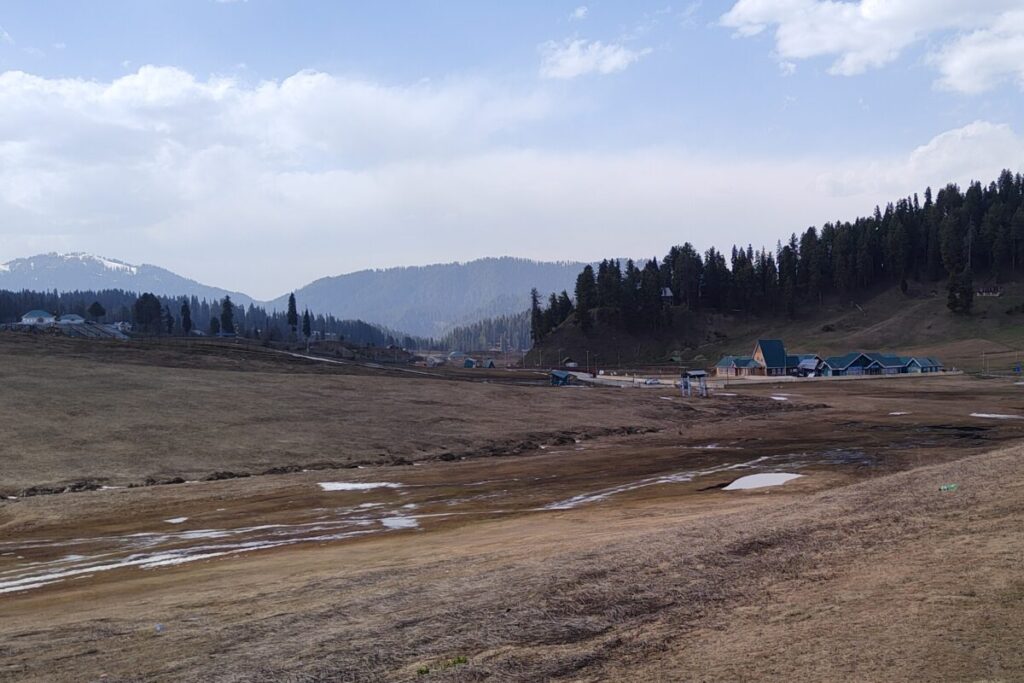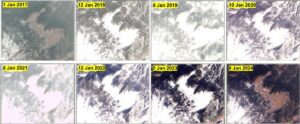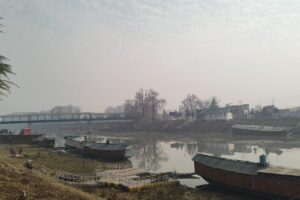Long Dry Weather Hits J&K’s Forests, Glaciers And Water Bodies
Jan 24, 2024 | Pratirodh Bureau
Absence of snow in Gulmarg. Normally blanketed in snow at this time, Gulmarg, known for skiing, currently stands bare, affecting tourism (Photo by Mudassir Kuloo)
Jammu and Kashmir has been witnessing dry weather over the past six weeks, posing a significant threat to the region’s biodiversity. Experts warn of adverse impacts on water bodies, glaciers and key sectors such as agriculture, horticulture and tourism.
The state is currently undergoing an extended period of dry weather during the 40-day harsh winter phase known as Chillai Kalan, the coldest stretch of winter observed from December 21 to January 29 annually.
Jammu and Kashmir experienced a rainfall deficit of 79% in this period, recording 12.6 mm rainfall in December 2023, which is below the average of 59.6 mm, as per the official data from the India Meteorological Department. The dry spell has continued in January, which is considered the coldest month when the valley normally receives maximum snowfall.
The region has also been experiencing temperatures 6-8°C above the winter average. On January 13, the city of Srinagar recorded a maximum temperature of 15°C, marking the highest January temperature in the past two decades.

Director of the Meteorological Department (MET) in Kashmir, Mukhtar Ahmad attributed this dry weather to El Niño.
El Niño is a climatic phenomenon that occurs when there is an unusual warming of surface waters in the eastern tropical Pacific ocean, representing the warm phase of the El Niño-Southern Oscillation (ENSO). This warming leads to increased sea surface temperatures in the central and eastern tropical Pacific ocean. The elevated temperatures induce a shift in atmospheric circulation, causing reduced rainfall over Indonesia, India and northern Australia. Conversely, it enhances rainfall and the formation of tropical cyclones over the tropical Pacific ocean.
In Kashmir, El Niño’s impact is observed through prolonged periods of dry weather, milder winters and reduced snowfall. Ahmad notes that the weather in Kashmir was previously influenced by the El Niño effect in January 1998, December 2014, January 2015 and December 2018.
Extreme Weather Patterns
The weather pattern of 2023 and January 2024 in Jammu and Kashmir witnessed contrasts and extremes, points out independent weather forecaster Faizan Arif.
“From a 42% surplus [rainfall] in January 2023 to a significant 79% shortfall in December 2023, Jammu and Kashmir experienced an overall 7% deficit in rainfall last year, illustrating the varied and unpredictable nature of the weather throughout the year. Similarly, we have had a snowless winter so far owing to which various key sectors would get affected,” he said.
In fact, after seven years, Kashmir is experiencing a snowless winter, said Irfan Rashid, a senior assistant professor at the Department of Geo-informatics, University of Kashmir (KU). “The snow in Chillai Kalaan is important for regulating glacier health and stream flows. The dry winters would mean higher mass loss of glaciers in this hydrological year. If the weather conditions do not improve, it might impact hydropower generation, irrigation, agriculture, and dependent sectors,” he said.
Irrigation Affected
The prolonged dry spell has negatively impacted crucial water sources, particularly the Jhelum river and other streams. Substantial decreases in water levels in surface sources have been noted, with the Jhelum river hitting its lowest point over the last many years. On January 14, the river’s flow was measured at minus 0.75 feet at Sangam (Anantnag district in south Kashmir), marking a level not seen since November 2017 and minus 0.86 feet at Asham (Bandipora district in north Kashmir). A negative reading indicates that the gauge reading is at or below the agreed-upon zero level of the river.
“The deficiency in timely snowfall and rainfall has led to a significant reduction in the water levels of surface water sources. It could cause water scarcity in the coming weeks,” said Sanjeev Malhotra, Chief Engineer of the Jal Shakti Department in Kashmir.
Insufficient water is impacting irrigation for agriculture and horticulture in the region, particularly orchard fields in Kashmir. An apple grower from north Kashmir’s Baramulla district Bashir Ahmad says that the absence of precipitation will negatively affect orchards in the upcoming season. “Snow also serves as a protective layer, protecting trees from extreme cold and providing essential chill hours for dormancy. The absence of this natural shield puts trees at risk and could reduce their productivity,” he added.
Akhtar H. Malik, a scientist at Department of Botany, University of Kashmir, adds that seed germination will also likely be affected without enough adequate chill and water. “The seeds require a chilling period in winter to germinate effectively during the spring season. Insufficient soil moisture during this period can adversely affect crop growth, leading to a decline in productivity,” he told Mongabay India.
Dry weather also increases the risk of forest fires. “The lack of precipitation leads to dry air, making even a small spark escalate into significant fires, as observed in the past month,” explained Malik. He notes that the dry conditions further impact wildlife by pushing them towards residential areas during forest fires.
Cascading Effects
Noted geoscientist and Vice Chancellor of the Islamic University of Sciences and Technology Kashmir, Shakil Ahmad Romshoo highlights that the absence of rain or snowfall would also elevate pollutant levels in the Kashmir Valley and pose health risks.
The prolonged dry spells and rising temperatures could also lead to significant consequences on glacier melting. “Glaciers are already melting due to climate change. Now dry weather and rising temperature will adversely affect glaciers in the Kashmir Himalayas,” he told Mongabay India.
Rashid adds that this could lead to hazards including Glacial Lake Outburst Flooding (GLOF), rock-ice avalanches, glacier detachments, and debris flows. GLOF is the term scientists use to describe when the water levels in glacial lakes breach their boundaries, causing large amounts of water to flow into nearby streams and rivers, creating flash floods.
Impacts On Tourism
The absence of snow has also impacted winter tourism in the region, particularly in Gulmarg and Pahalgam.
Places like Gulmarg are popular with tourists who typically flock to the region for skiing from December to March. Normally blanketed in snow, Gulmarg currently stands bare, impacting major skiing events and seasonal courses in various educational institutions.

Last winter, 55,000 tourists visited the valley, with a significant number visiting Gulmarg. However, this year, the snowless Gulmarg is almost empty. “We have less than 30 percent booking in hotels than previous winter,” said Farooq Ahmad, a manager of a hotel at Gulmarg. “Hotel occupancy has significantly decreased, with numerous cancellations reported, reflecting the current lack of tourist activity in the region. Our winter tourism is largely dependent on snow. If there is no snow, tourists won’t come here,” said Ahmad.
“We arrived in Kashmir on January 9. Since then, we have been waiting for snow. If there is no snowfall in a couple of days, I will return home,” said Mohammad Najeeb, a visitor from Mumbai, who had hoped for his son to learn skiing.
House Boat Owners’ Association President Manzoor Ahmad Pakhtoon said over 60 percent houseboats are empty in Dal and Nigeen Lake. “Majority of tourists have cancelled their bookings or put on hold due to dry weather,” he added.
(Published under Creative Commons from Mongabay-India. Read the original article here)
